Preferred Orientations of Magnetic Minerals Inferred from Magnetic Fabrics of Hantangang Quaternary Basalts
Abstract
:1. Introduction
2. Geological Setting
3. Methods
4. Results
4.1. Paleomagnetic Results
4.2. Mineral Magnetic Results
4.2.1. Thermomagnetic (K-T) Curves
4.2.2. Hysteresis Parameters
4.3. Anisotropy of Magnetic Susceptibility (AMS) Results
4.4. Anisotropy of Anhysteretic Remanent Magnetization (AARM) Results
5. Discussion
5.1. Paleomagnetic Implications for the Age of Eruption
5.2. Single Domain Effect on Magnetic Fabrics
5.3. Inferred Lava Flow Direction
Supplementary Materials
Author Contributions
Funding
Acknowledgments
Conflicts of Interest
References
- Kil, Y.; Ahn, K.S.; Woo, K.S.; Lee, K.C.; Jwa, Y.J.; Jung, W.; Sohn, Y.K. Geoheritage values of the Quaternary Hantangang river volcanic field in the central Korean Peninsula. Geoheritage 2019, 11, 765–782. [Google Scholar] [CrossRef]
- Won, J.K. A study on the Quaternary volcanism in the Korean peninsula. J. Geol. Soc. Korea 1983, 19, 159–168, (In Korean with English abstract). [Google Scholar]
- Kim, K.H.; Kim, O.J.; Min, K.D.; Lee, Y.S. Structural, paleomagnetic and petrological studies of the Chugaryeong Rift Valley. Econ. Environ. Geol. 1984, 17, 215–230, (In Korean with English abstract). [Google Scholar]
- Won, C.K.; Kim, Y.K.; Lee, M.W. The study on the geochemistry of Choogaryong Alkali Basalt. J. Geol. Soc. Korea 1990, 26, 70–81, (In Korean with English abstract). [Google Scholar]
- Song, M.Y.; Shin, K.S. Satellite image analysis for the geologic structure and land surface environments in the Chugaryung rift valley near Cholwon. J. Korean Earth Sci. Soc. 1998, 19, 675–683. [Google Scholar]
- Lee, M.B.; Lee, G.R.; Kim, N.S. Drainage derangement and revision by the formation of Cheolwon-Pyeonggang lava plateau in Chugaryeong rift valley, central Korea. J. Korean Geogr. 2004, 39, 833–844, (In Korean with English abstract). [Google Scholar]
- Won, C.K.; Lee, M.W.; Jin, M.S.; Choi, M.J.; Jeong, B.H. Geological Survey in the Hantangang River; Jisungsa: Seoul, Republic of Korea, 2010; p. 232. (In Korean) [Google Scholar]
- Lee, M.B.; Lee, G.R. A study of regional geomorphology in the Chugaryeong tectonic valley, central Korea. J. Korean Geogr. 2016, 51, 473–490, (In Korean with English abstract). [Google Scholar]
- Hakim, W.L.; Ramayanti, S.; Park, S.; Ko, B.; Cheong, D.K.; Lee, C.W. Estimating the Pre-Historical volcanic eruption in the Hantangang River volcanic field: Experimental and simulation study. Remote Sens. 2022, 14, 894. [Google Scholar]
- Tarling, D.; Hrouda, F. (Eds.) Magnetic Anisotropy of Rocks; Springer Science & Business Media: London, UK, 1993; p. 218. [Google Scholar]
- Henry, B.; Jordanova, D.; Jordanova, N.; Souque, C.; Robion, P. Anisotropy of magnetic susceptibility of heated rocks. Tectonophysics 2003, 366, 241–258. [Google Scholar]
- Cañón-Tapia, E.; Walker, G.P.; Herrero-Bervera, E. Magnetic fabric and flow direction in basaltic pahoehoe lava of Xitle volcano, Mexico. J. Volcanol. 1995, 65, 249–263. [Google Scholar]
- Cañón-Tapia, E.; Walker, G.P.; Herrero-Bervera, E. The internal structure of lava flows—Insights from AMS measurements I: Near-vent a’a. J. Volcanol. 1996, 70, 21–36. [Google Scholar]
- Cañón-Tapia, E.; Walker, G.P.; Herrero-Bervera, E. The internal structure of lava flows—Insights from AMS measurements II: Hawaiian pahoehoe, toothpaste lava and ‘a’ā. J. Volcanol. 1997, 76, 19–46. [Google Scholar]
- Cañón-Tapia, E.; Pinkerton, H. The anisotropy of magnetic susceptibility of lava flows: An experimental approach. J. Volcanol. 2000, 98, 219–233. [Google Scholar]
- Cañón-Tapia, E. Anisotropy of magnetic susceptibility of lava flows and dykes: A historical account. Geol. Soc. Spec. Publi. 2004, 238, 205–225. [Google Scholar]
- Herrero-Bervera, E.; Cañon-Tapia, E.; Walker, G.P.; Tanaka, H. Magnetic fabrics study and inferred flow directions of lavas of the Old Pali Road, O′ ahu, Hawaii. J. Volcanol. 2002, 118, 161–171. [Google Scholar]
- Gurioli, L.; Zanella, E.; Pareschi, M.T.; Lanza, R. Influences of urban fabric on pyroclastic density currents at Pompeii (Italy): 1. Flow direction and deposition. J. Geophys. Res. Solid Earth 2007, 112, B05214. [Google Scholar] [CrossRef] [Green Version]
- Loock, S.; Diot, H.; de Vries, B.V.W.; Launeau, P.; Merle, O.; Vadeboin, F.; Petronis, M.S. Lava flow internal structure found from AMS and textural data: An example in methodology from the Chaîne des Puys, France. J. Volcanol. 2008, 177, 1092–1104. [Google Scholar]
- Maffione, M.; Pucci, S.; Sagnotti, L.; Speranza, F. Magnetic fabric of Pleistocene continental clays from the hanging-wall of an active low-angle normal fault (Altotiberina Fault, Italy). Int. J. Earth Sci. 2012, 101, 849–861. [Google Scholar]
- Závada, P.; Kratinová, Z.; Kusbach, V.; Schulmann, K. Internal fabric development in complex lava domes. Tectonophysics 2009, 466, 101–113. [Google Scholar]
- Boiron, T.; Bascou, J.; Camps, P.; Ferré, E.C.; Maurice, C.; Guy, B.; Launeau, P. Internal structure of basalt flows: Insights from magnetic and crystallographic fabrics of the La Palisse volcanics, French Massif Central. Geophys. J. Int. 2013, 193, 585–602. [Google Scholar]
- Hrouda, F.; Verner, K.; Kubinova, S.; Burianek, D.; Faryad, S.W.; Chlupacova, M.; Holub, F. Magnetic fabric and emplacement of dykes of lamprophyres and related rocks of the Central Bohemian Dyke Swarm (Central European Variscides). J. Geosci. 2016, 61, 335–354. [Google Scholar] [CrossRef] [Green Version]
- Bradák, B.; Seto, Y.; Chadima, M.; Kovács, J.; Tanos, P.; Újvári, G.; Hyodo, M. Magnetic fabric of loess and its significance in Pleistocene environment reconstructions. Earth Sci. Rev. 2020, 210, 103385. [Google Scholar]
- Moncinhatto, T.R.; Haag, M.B.; Hartmann, G.A.; Savian, J.F.; Poletti, W.; Sommer, C.A.; Trindade, R.I. Mineralogical control on the magnetic anisotropy of lavas and ignimbrites: A case study in the Caviahue-Copahue field (Argentina). Geophy. J. Int. 2020, 220, 821–838. [Google Scholar]
- Hrouda, F.; Chadima, M.; Ježek, J. Anisotropy of out-of-phase magnetic susceptibility and its potential for rock fabric studies: A review. Geosciences 2022, 12, 234. [Google Scholar]
- Suk, D.W. A Paleomagnetic Study on Basalt Distributed in the Jeongok Area and Hantangan River Basins. Master’s Thesis, Yonsei University, Seoul, Republic of Korea, 2 February 1982. (In Korean with English abstract). [Google Scholar]
- Lee, Y.S.; Min, K.D.; Hwang, J.H. The Geodynamic evolution of the Chugaryeong fault valley in a view point of paleomagnetism. Econ. Environ. Geol. 2001, 34, 555–571, (In Korean with English abstract). [Google Scholar]
- Kim, B.C.; Hwang, J.H.; Lee, Y.S.; Nahm, W.H. Paleomagnetic and Soil Chemical Studies on the Quaternary Paleosol Around the Hantan River. Econ. Environ. Geol. 2004, 37, 325–334, (In Korean with English abstract). [Google Scholar]
- Lee, Y.S.; Torii, M.; Nishimura, S.; Min, K.D. Apparent polar wander path for the Southern part of Korean Peninsula. In Proceedings of the 29th International Geological Congress, Kyoto, Japan, 24 August–3 September 1992. [Google Scholar]
- Lee, Y.S.; Nishimura, S.; Min, K.D. Paleomagnetotectonics of east Asia in the Proto-Tethys Ocean. Tectonophysics 1997, 270, 157–166. [Google Scholar]
- Min, K.D.; Lee, Y.S. Phanerozoic Geodynamics of the Korean Peninsula. Econ. Environ. Geol. 2006, 39, 353–368, (In Korean with English abstract). [Google Scholar]
- Danhara, T.; Bae, K.; Okada, T.; Matsufuji, K.; Hwang, S. What is the real age of the Chongokni Paleolithic site? A new approach by fission track dating, K-Ar dating and tephra analysis. In Paleolithic Archaeology in Northeast Asia; Bae, K., Lee, J.C., Eds.; Yeoncheon County & The Institute of Cutural Properties: Seoul, Republic of Korea, 2002; pp. 77–116. [Google Scholar]
- Takayanagi, M. Dating of the basalt rock. In Report on the excavation of Chongokri site; National Research Institute of Cultural Heritage: Seoul, Republic of Korea, 1983; pp. 586–588, (In Korean and Japanese). [Google Scholar]
- Yi, S.; Lee, Y.; Lim, H. Basic study on geological development of Paleolithic sites along Imjin Basin (I); Seoul National University Museum: Seoul, Republic of Korea, 2005; p. 104. (In Korean) [Google Scholar]
- Ryu, S.; Oka, M.; Yagi, K.; Sakuyama, T.; Itaya, T. K-Ar ages of the Quaternary basalts in the Jeongok area, the central part of Korean Peninsula. Geosci. J. 2011, 15, 1–8. [Google Scholar]
- Seong, Y.B. Burial age dating of geomorphic event using multiple cosmogenicradioactive nuclides: A case study on the first flow of Jeongok basalt over Baekeuri formation. J. Korean Geomorphol. Assoc. 2007, 14, 1–7, (In Korean with English abstract). [Google Scholar]
- Lee, M.B.; Seong, Y.B.; Lee, G.R. Formative age and process on basalt of lava plateau in the Cheolwon and Yeoncheon areas, central Korea. J. Korean Geomorphol. Assoc. 2020, 27, 41–51. [Google Scholar]
- Jelínek, V. The Statistical Theory of Measuring Anisotropy of Magnetic Susceptibility of Rocks and Its Application; Geofyzika: Brno, Czech Republic, 1977; Volume 29, pp. 1–87. [Google Scholar]
- Hext, G.R. The estimation of second-order tensors, with related tests and designs. Biometrika 1963, 50, 353–373. [Google Scholar]
- Tauxe, L. PmagPy, Software Package. 2011. Available online: https://pmagpy.github.io/PmagPy-docs/intro.html (accessed on 6 July 2023).
- Jelinek, V. Characterization of the magnetic fabric of rocks. Tectonophysics 1981, 79, 63–67. [Google Scholar] [CrossRef]
- Jackson, M. Anisotropy of magnetic remanence: A brief review of mineralogical sources, physical origins, and geological applications, and comparison with susceptibility anisotropy. Pure Appl. Geophys. 1991, 136, 1–28. [Google Scholar]
- Zijderveld, J.D.A. AC demagnetization of rocks: Analysis of results. In Methods in Paleomagnetism; Collinson, D.W., Creer, K.M., Runcorn, S.K., Eds.; Elsevier: New York, NY, USA, 1967; pp. 254–286. [Google Scholar]
- Kirschvink, J.L. The least-squares line and plane and the analysis of palaeomagnetic date. Geophys. J. R. Astron. Soc. 1980, 62, 699–718. [Google Scholar]
- Tauxe, L.; Constable, C.; Johnson, C.L.; Koppers, A.A.P.; Miller, W.R.; Staudigel, H. Paleomagnetism of the southwestern U.S.A. recorded by 0-5 Ma igneous rocks. Geochem. Geophys. Geosys. 2003, 4, 8802. [Google Scholar] [CrossRef]
- Moskowitz, B.M.; Jackson, M.; Kissel, C. Low-temperature magnetic behavior of titanomagnetites. Earth Plant. Sci. Lett. 1998, 157, 141–149. [Google Scholar] [CrossRef]
- Dunlop, D.J.; Özdemir, Ö. Rock Magnetism: Fundamentals and Frontiers; Cambridge University Press: Cambridge, UK, 1997; p. 573. [Google Scholar]
- Bascou, J.; Camps, P.; Dautria, J.M. Magnetic versus crystallographic fabrics in a basaltic lava flow. J. Volcanol. 2005, 145, 119–135. [Google Scholar]
- Vlag, P.; Alva-Valdivia, L.; De Boer, C.B.; Gonzalez, S.; Urrutia-Fucugauchi, J. A rock-and paleomagnetic study of a Holocene lava flow in central Mexico. Phys. Earth Planet. Inter. 2000, 118, 259–272. [Google Scholar]
- Day, R.; Fuller, M.; Schmidt, V.A. Hysteresis properties of titanomagnetites: Grain-size and compositional dependence. Phys. Earth Planet. Inter. 1977, 13, 260–267. [Google Scholar]
- Dunlop, D.J. Theory and application of the Day plot (Mrs/Ms versus Hcr/Hc) 2. Application to data for rocks, sediments, and soils. J. Geophys. Res. Solid Earth 2002, 107, 2057. [Google Scholar] [CrossRef] [Green Version]
- Roberts, A.P.; Tauxe, L.; Heslop, D.; Zhao, X.; Jiang, Z. A critical appraisal of the “Day” diagram. J. Geophys. Res. Solid Earth 2018, 123, 2618–2644. [Google Scholar]
- Tauxe, L.; Mullender, T.A.T.; Pick, T. Potbellies, wasp-waists, and superparamagnetism in magnetic hysteresis. J. Geophys. Res. Solid Earth 1996, 101, 571–583. [Google Scholar] [CrossRef]
- Jackson, M.; Moskowitz, B.; Rosenbaum, J.; Kissel, C. Field-dependence of AC susceptibility in titanomagnetites. Earth Planet. Sci. Lett. 1998, 157, 129–139. [Google Scholar] [CrossRef]
- Hrouda, F. Magnetic anisotropy of rocks and its application in geology and geophysics. Geophys. Surv. 1982, 5, 37–82. [Google Scholar]
- Tauxe, L. Paleomagnetic Principles and Practice; Kluwer Academic Publishers: Dordrecht, The Netherlands, 1998; pp. 230–240. [Google Scholar]
- Ellwood, B.B. Flow and emplacement direction determined for selected basaltic bodies using magnetic susceptibility anisotropy measurements. Earth Planet. Sci. Lett. 1978, 41, 254–264. [Google Scholar]
- McCabe, C.; Jackson, M.; Ellwood, B.B. Magnetic anisotropy in the trenton limestone: Results of a new technique, anisotropy of anhysteretic susceptibility. Geophys. Res. Lett. 1985, 12, 333–336. [Google Scholar]
- Stephenson, A.; Sadikun, S.T.; Potter, D.K. A theoretical and experimental comparison of the anisotropies of magnetic susceptibility and remanence in rocks and minerals. Geophys. J. Int. 1986, 84, 185–200. [Google Scholar]
- Rochette, P.; Jackson, M.; Aubourg, C. Rock magnetism and the interpretation of anisotropy of magnetic susceptibility. Rev. Geophys. 1992, 30, 209–226. [Google Scholar] [CrossRef]
- Rochette, P.; Aubourg, C.; Perrin, M. Is this magnetic fabric normal? A review and case studies in volcanic formations. Tectonophysics 1999, 307, 219–234. [Google Scholar]
- McElhinny, M.W.; McFadden, P.L. Palaeosecular variation over the past 5 Myr based on a new generalized database. J. Geophys. Res. Solid Earth 1997, 131, 240–252. [Google Scholar]
- Krása, D.; Herrero-Bervera, E. Alteration induced changes of magnetic fabric as exemplified by dykes of the Koolau volcanic range. Earth. Planet. Sci. Lett. 2005, 240, 445–453. [Google Scholar]
- Park, J.K.; Tanczyk, E.I.; Desbarats, A. Magnetic fabric and its significance in the 1400 Ma Mealy diabase dykes of Labrador, Canada. J. Geophys. Res. Solid Earth 1988, 93, 13689–13704. [Google Scholar]
- Potter, D.K.; Stephenson, A. Single-domain particles in rocks and magnetic fabric analysis. Geophys. Res. Lett. 1988, 15, 1097–1100. [Google Scholar] [CrossRef]
- Rochette, P. Inverse magnetic fabric in carbonate-bearing rocks. Earth Planet. Sci. Lett. 1988, 90, 229–237. [Google Scholar] [CrossRef]
- Knight, M.D.; Walker, G.P. Magma flow directions in dikes of the Koolau Complex, Oahu, determined from magnetic fabric studies. J. Geophys. Res. Solid Earth 1988, 93, 4301–4319. [Google Scholar]
- Tauxe, L.; Gee, J.S.; Staudigel, H. Flow directions in dikes from anisotropy of magnetic susceptibility data: The bootstrap way. J. Geophys. Res. Solid Earth 1998, 103, 17775–17790. [Google Scholar]
- Hillhouse, J.W.; Wells, R.E. Magnetic fabric, flow directions, and source area of the lower Miocene Peach Springs Tuff in Arizona, California, and Nevada. J. Geophys. Res. Solid Earth 1991, 96, 12443–12460. [Google Scholar]
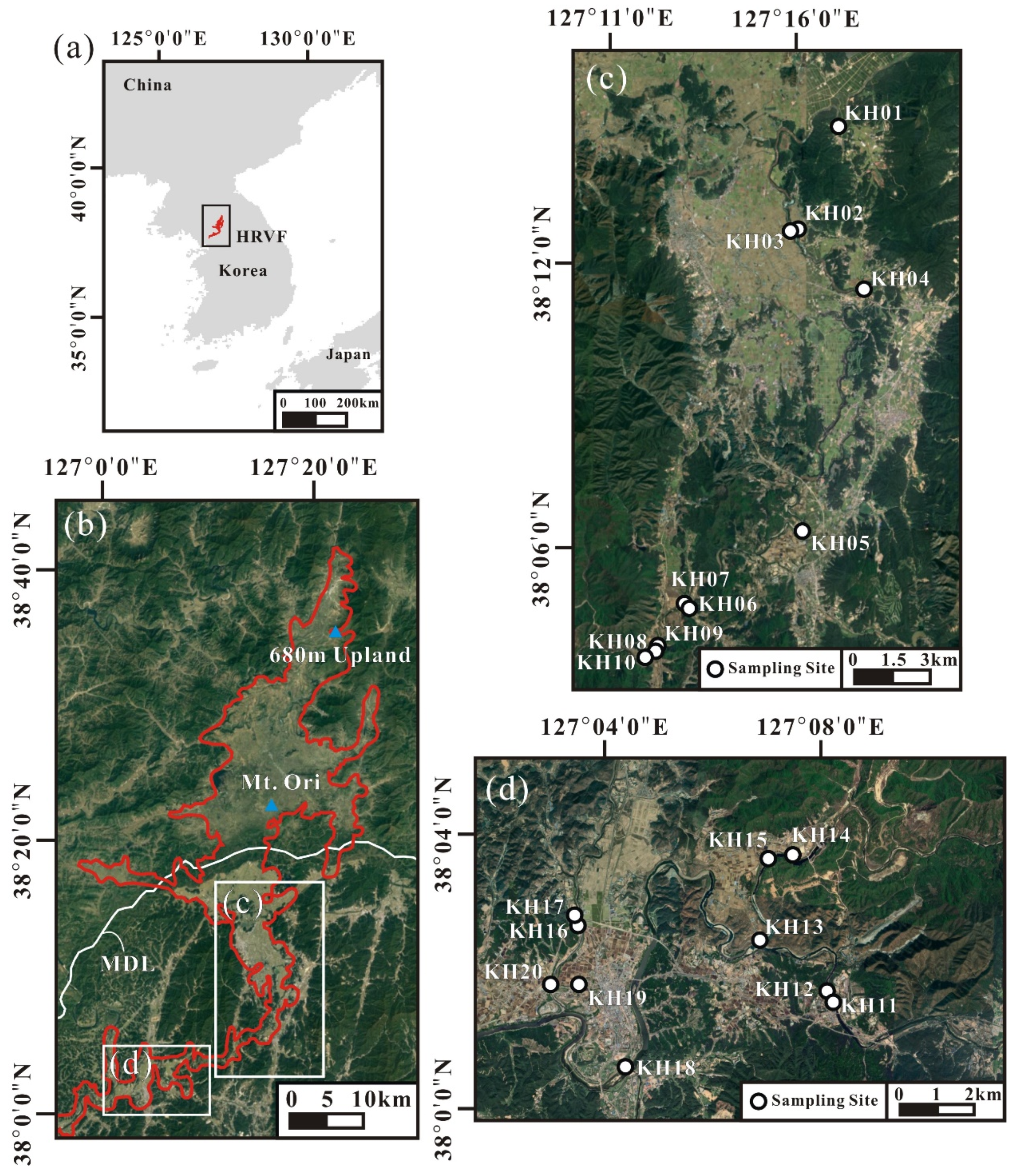
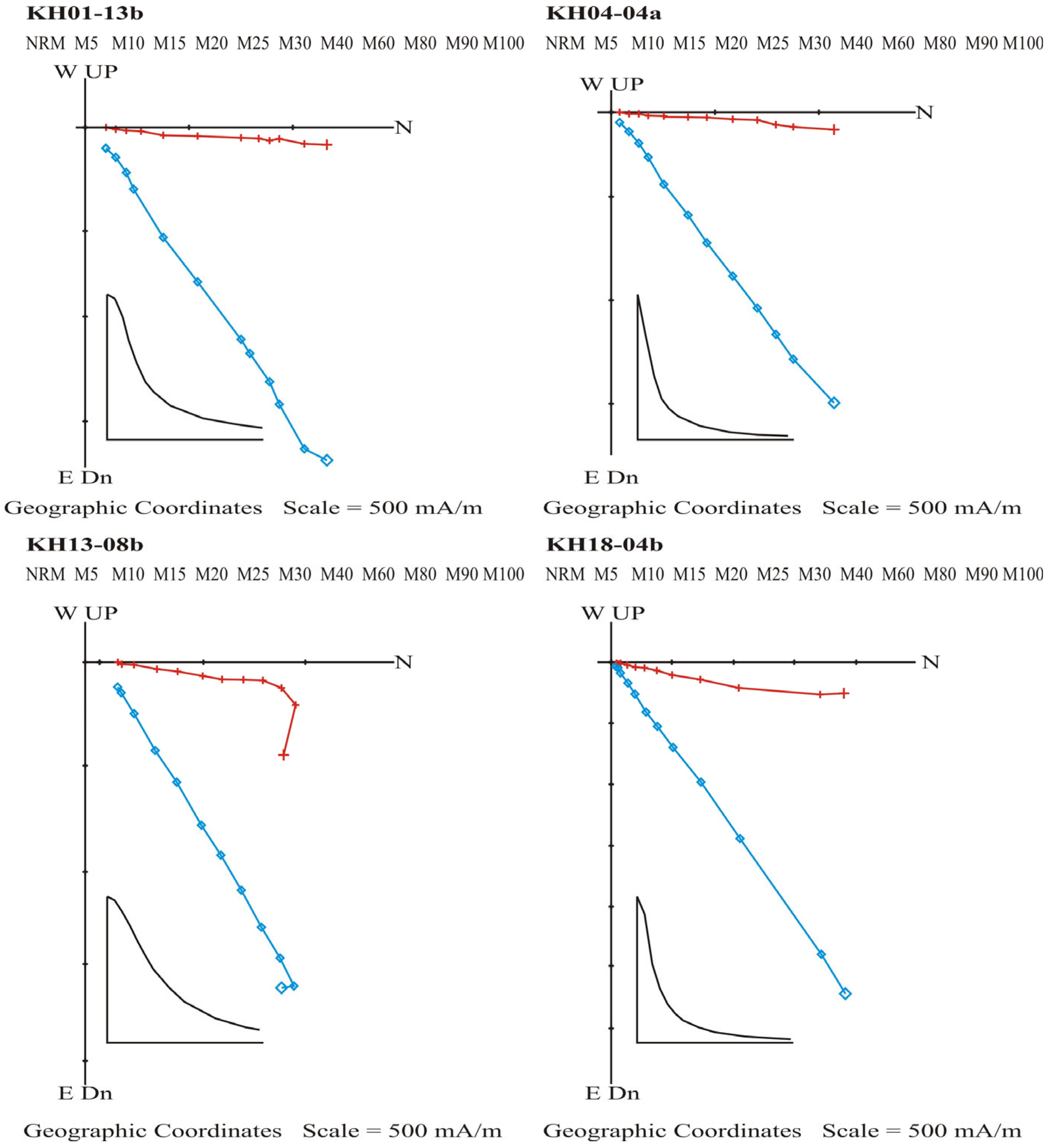
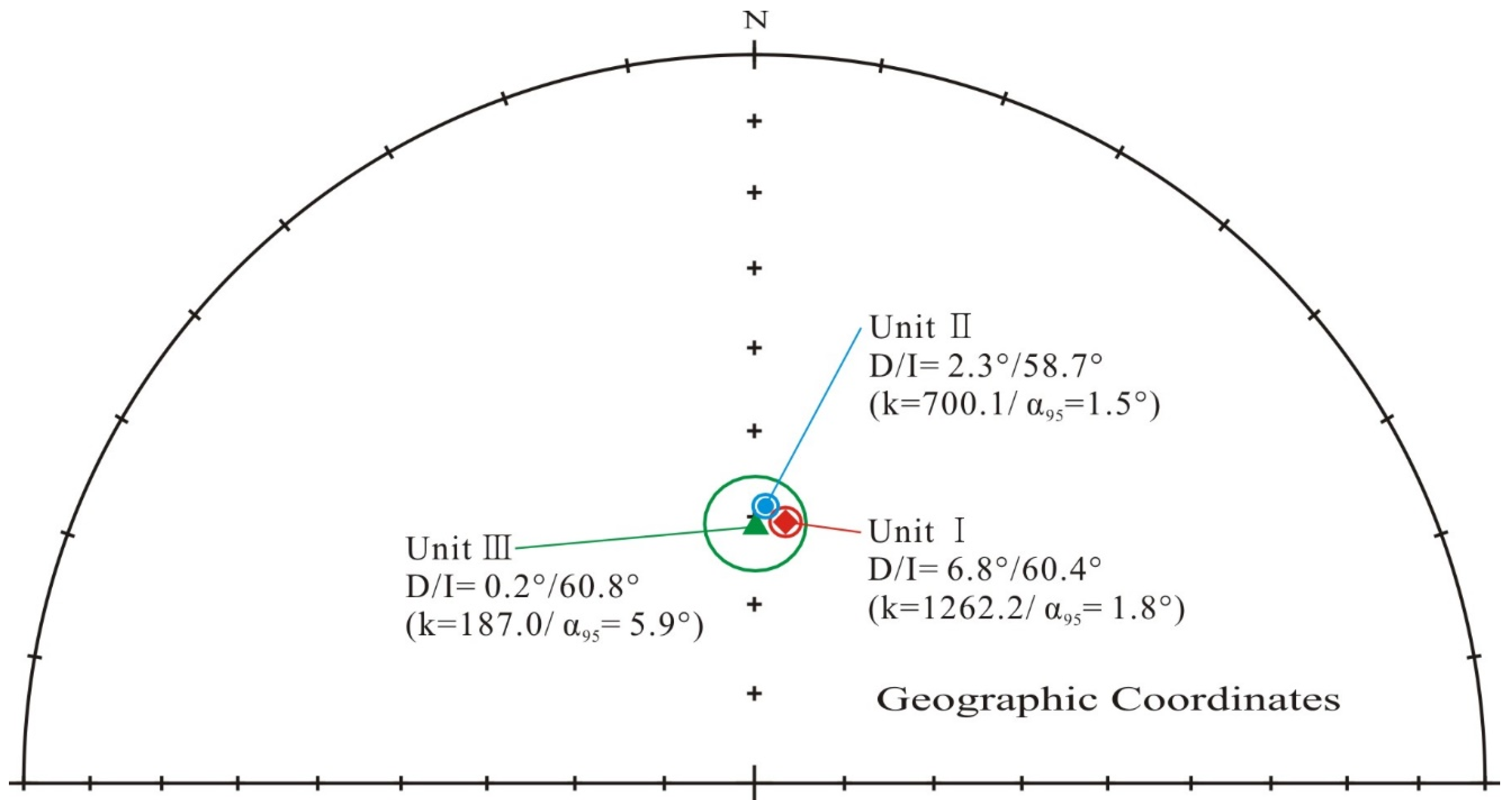



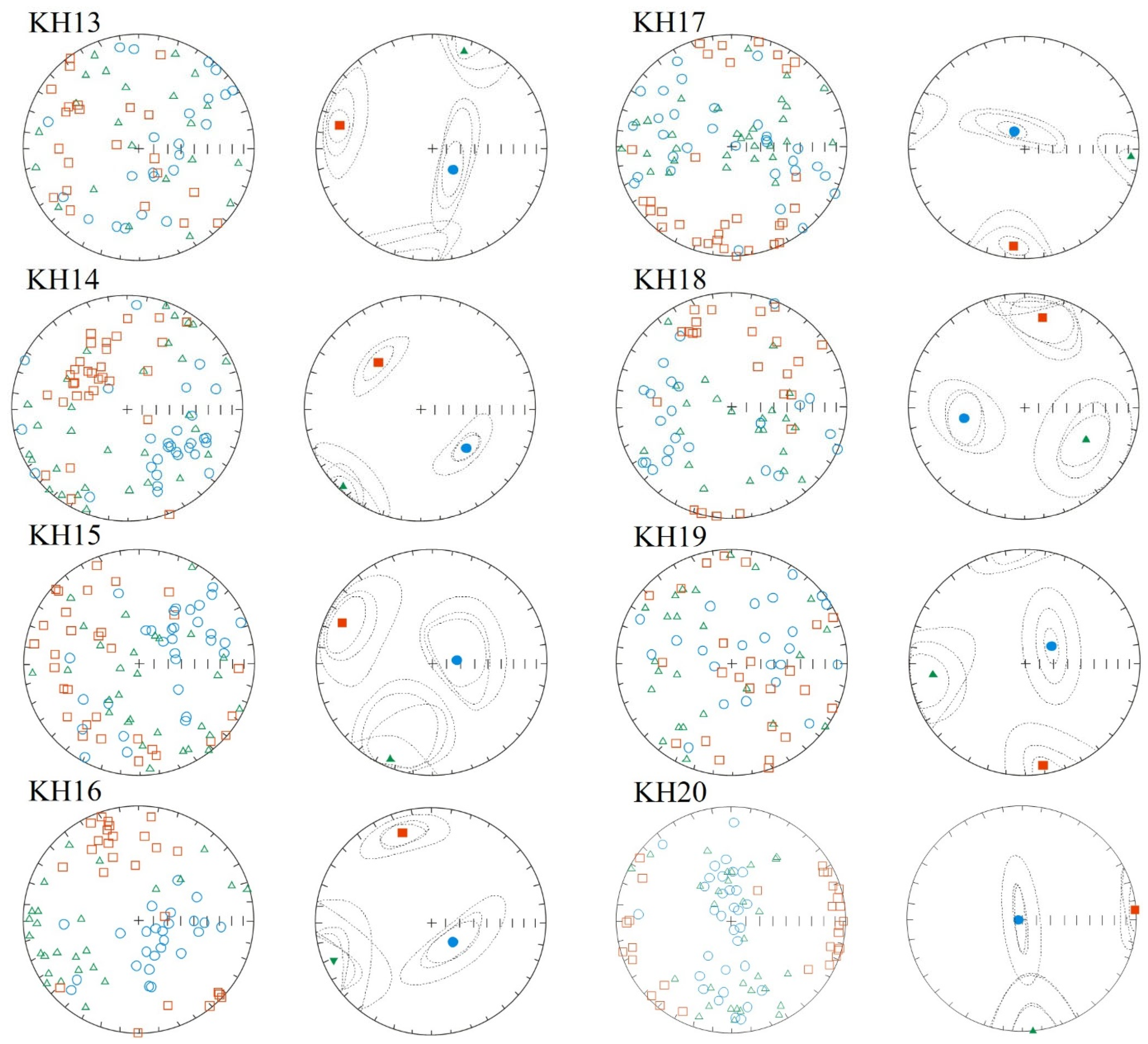
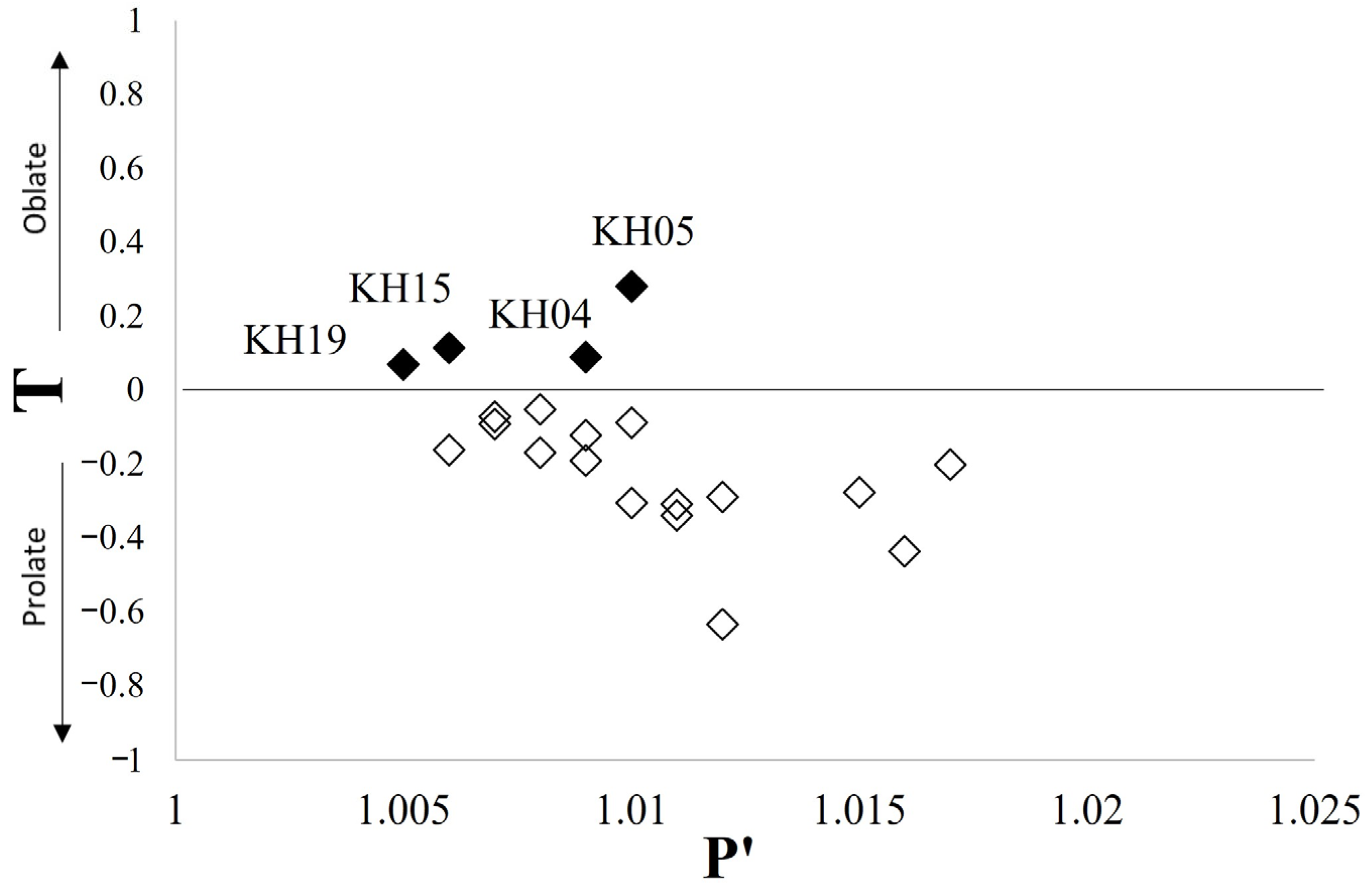
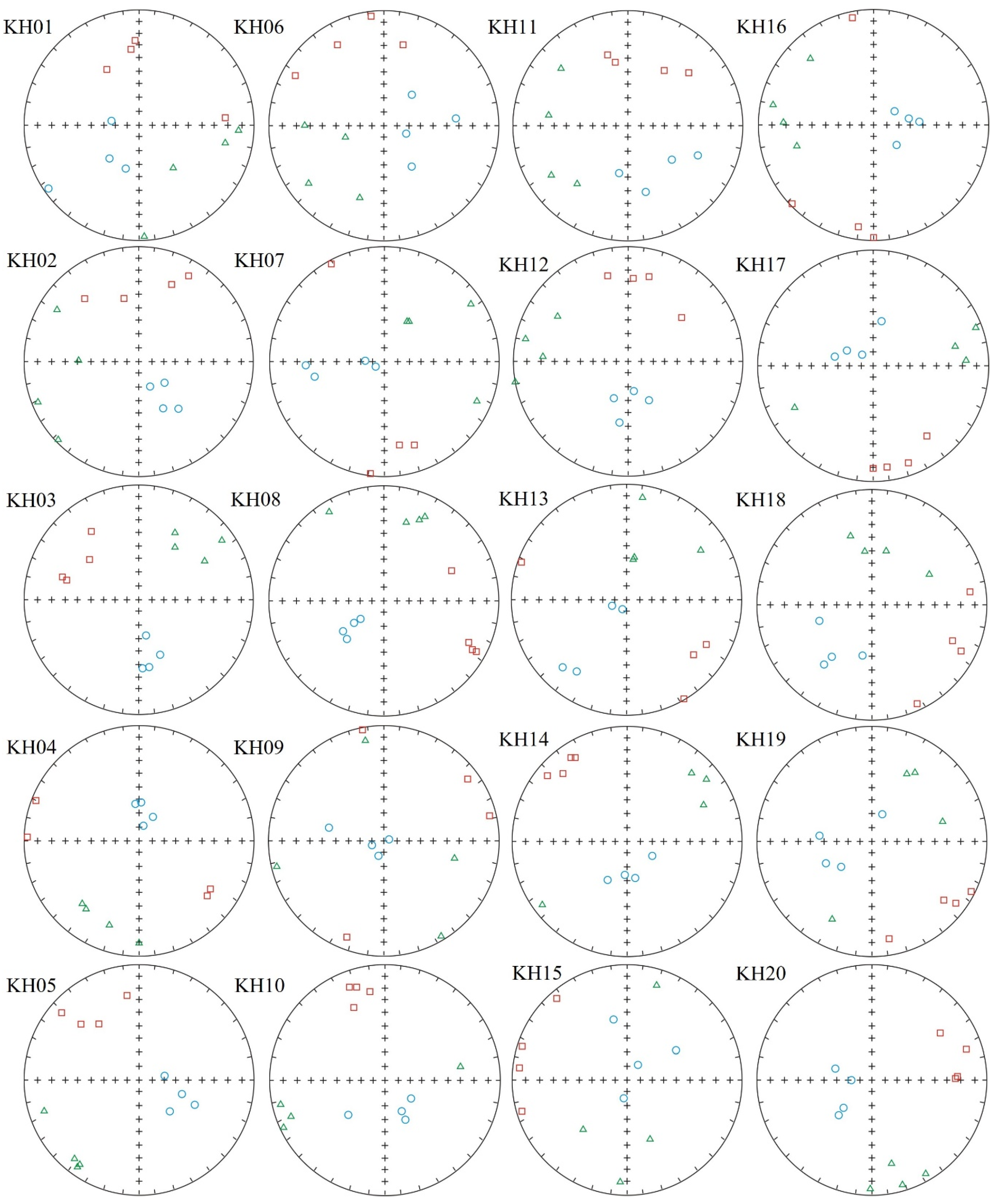
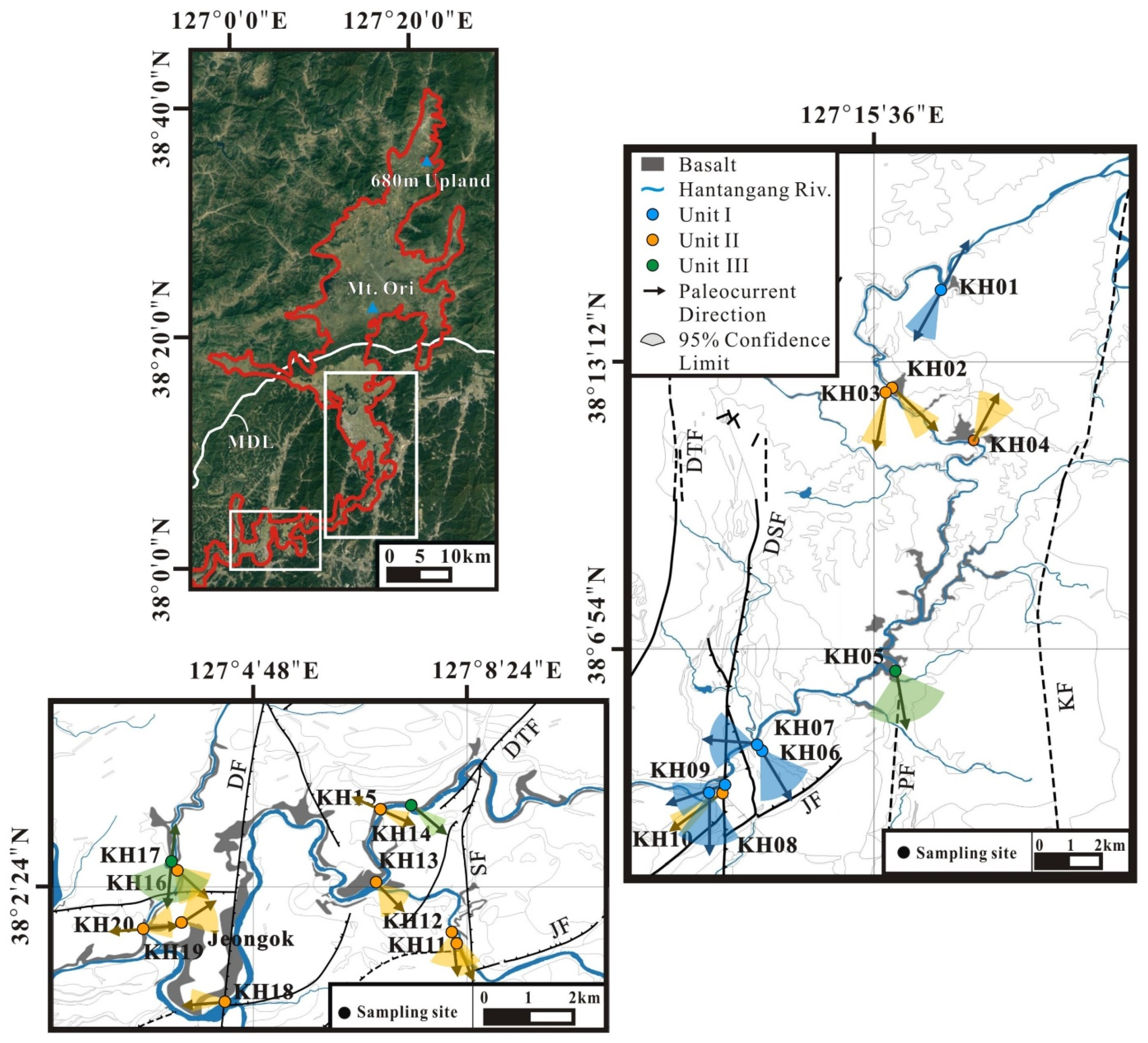
| Unit | Site | n/N | Dec (°) | Inc (°) | k | α95 (°) | Sampling Site Location | ||
|---|---|---|---|---|---|---|---|---|---|
| Lat (°N) | Long (°E) | Elev (m) | |||||||
| Ⅰ | KH01 | 17/18 | 6.0 | 59.6 | 162.2 | 2.6 | 38.2466 | 127.2864 | 188.1 |
| KH06 | 33/33 | 10.8 | 60.8 | 640.6 | 1.0 | 38.0803 | 127.2236 | 106.0 | |
| KH07 | 22/24 | 8.5 | 62.4 | 227.7 | 2.0 | 38.0789 | 127.2178 | 113.0 | |
| KH09 | 20/21 | 1.2 | 60.5 | 118.5 | 2.9 | 38.0628 | 127.2069 | 143.0 | |
| KH10 | 26/26 | 7.4 | 58.5 | 761.1 | 1.0 | 38.0617 | 127.2003 | 143.0 | |
| Unit Mean | 6.8 | 60.4 | 1262.2 | 1.8 | |||||
| Ⅱ | KH02 | 18/20 | 0.1 | 59.2 | 277.5 | 2.0 | 38.2105 | 127.2658 | 150.2 |
| KH03 | 11/12 | 352.8 | 57.4 | 584.3 | 1.8 | 38.2105 | 127.2658 | 150.2 | |
| KH04 | 17/18 | 6.6 | 58.2 | 246.2 | 2.2 | 38.1907 | 127.2887 | 125.3 | |
| KH08 | 14/16 | 356.9 | 61.2 | 350.4 | 2.0 | 38.0655 | 127.2047 | 96.7 | |
| KH11 | 15/16 | 3.8 | 61.1 | 131.1 | 3.2 | 38.0241 | 127.1375 | 61.6 | |
| KH12 | 8/10 | 6.9 | 60.0 | 249.0 | 3.1 | 38.0256 | 127.1372 | 61.8 | |
| KH13 | 5/17 | 4.6 | 58.1 | 741.0 | 2.3 | 38.0405 | 127.1134 | 50.7 | |
| KH15 | 28/31 | 8.5 | 59.1 | 497.2 | 1.2 | 38.0614 | 127.1166 | 49.3 | |
| KH16 | 25/25 | 357.3 | 55.7 | 373.1 | 1.5 | 38.0449 | 127.0577 | 29.1 | |
| KH18 | 19/23 | 1.8 | 56.7 | 476.1 | 1.5 | 38.0112 | 127.0727 | 39.1 | |
| KH19 | 24/24 | 8.1 | 58.3 | 713.7 | 1.1 | 38.0300 | 127.0602 | 43.4 | |
| KH20 | 32/32 | 1.1 | 58.5 | 131.1 | 2.2 | 38.0283 | 127.0481 | 54.3 | |
| Unit Mean | 2.3 | 58.7 | 700.1 | 1.5 | |||||
| Ⅲ | HK05 | 35/35 | 9.5 | 62.4 | 671.2 | 0.9 | 38.1072 | 127.2688 | 124.6 |
| KH14 | 30/30 | 347.4 | 59.5 | 694.8 | 1.0 | 38.0625 | 127.1201 | 80.5 | |
| KH17 | 28/31 | 4.4 | 59.5 | 317.1 | 1.5 | 38.0455 | 127.0575 | 63.1 | |
| Unit Mean | 0.2 | 60.8 | 187.0 | 5.9 | |||||
| Site (Unit) | N | Km (10−3 SI) | Mean AMS parameters | Kmax | Kint | Kmin | ||||
|---|---|---|---|---|---|---|---|---|---|---|
| P’ | T | Dec (°) | Inc (°) | Dec (°) | Inc (°) | Dec (°) | Inc (°) | |||
| KH01(I) | 30 | 1.282 | 1.016 | −0.4366 | 207.2 | 38.5 | 14.6 | 50.8 | 112.3 | 6.2 |
| KH02(II) | 24 | 1.437 | 1.015 | −0.2760 | 133.4 | 39.3 | 248.9 | 27.7 | 3.3 | 38.2 |
| KH03(II) | 22 | 1.296 | 1.010 | −0.0893 | 182.0 | 52.7 | 57.7 | 23.2 | 314.8 | 27.4 |
| KH04(II) | 18 | 1.493 | 1.009 | 0.0885 | 198.1 | 35.1 | 108.1 | 0.1 | 17.9 | 54.9 |
| KH05(III) | 35 | 3.300 | 1.010 | 0.2804 | 337.1 | 22.7 | 69.0 | 4.4 | 169.4 | 66.9 |
| KH06(I) | 33 | 3.147 | 1.009 | −0.1903 | 312.3 | 34.0 | 52.2 | 14.2 | 161.4 | 52.3 |
| KH07(I) | 24 | 1.903 | 1.011 | −0.3391 | 151.2 | 12.5 | 56.8 | 19.0 | 272.6 | 67.0 |
| KH08(II) | 27 | 0.974 | 1.012 | −0.6346 | 234.6 | 43.3 | 355.2 | 28.5 | 106.2 | 33.4 |
| KH09(I) | 23 | 3.783 | 1.010 | −0.3054 | 65.2 | 23.8 | 155.6 | 1.0 | 247.9 | 66.2 |
| KH10(I) | 33 | 6.532 | 1.006 | −0.1616 | 15.6 | 33.6 | 281.2 | 6.6 | 181.6 | 55.6 |
| KH11(II) | 30 | 1.293 | 1.012 | −0.2887 | 158.3 | 47.8 | 336.4 | 42.2 | 67.2 | 1.0 |
| KH12(II) | 22 | 1.112 | 1.009 | −0.1227 | 173.4 | 47.4 | 353.3 | 42.6 | 83.4 | 0.1 |
| KH13(II) | 22 | 1.881 | 1.008 | −0.0523 | 284.5 | 18.1 | 17.8 | 10.1 | 135.7 | 69.1 |
| KH14(III) | 30 | 2.315 | 1.007 | −0.0719 | 318.8 | 42.0 | 225.2 | 4.1 | 130.7 | 47.7 |
| KH15(II) | 31 | 2.060 | 1.006 | 0.1137 | 295.4 | 13.4 | 203.3 | 8.8 | 81.1 | 73.9 |
| KH16(II) | 25 | 4.856 | 1.017 | −0.2017 | 342.4 | 17.9 | 249.3 | 9.7 | 132.2 | 69.5 |
| KH17(III) | 31 | 2.315 | 1.007 | −0.0924 | 186.2 | 12.1 | 94.4 | 8.4 | 330.4 | 75.2 |
| KH18(II) | 23 | 2.075 | 1.009 | 0.0528 | 11.0 | 19.5 | 117.3 | 38.4 | 260.1 | 45.1 |
| KH19(II) | 24 | 2.130 | 1.005 | 0.0696 | 170.3 | 9.7 | 263.8 | 19.7 | 55.4 | 67.8 |
| KH20(II) | 32 | 2.140 | 1.011 | −0.3096 | 84.2 | 2.2 | 174.2 | 0.6 | 279.7 | 87.7 |
| Site (Unit) | N | Mean AARM Parameters | AMS Fabric Type | |||||||
|---|---|---|---|---|---|---|---|---|---|---|
| P’ | T | Dec (°) | Inc (°) | Dec (°) | Inc (°) | Dec (°) | Inc (°) | |||
| KH01(I) | 4 | 1.117 | 0.0419 | 351.6 | 29.4 | 95.2 | 22.8 | 216.9 | 51.4 | Int (Group 2) |
| KH02(II) | 4 | 1.078 | 0.2234 | 0.7 | 26.9 | 262.4 | 15.7 | 145.4 | 58.2 | Inverse |
| KH03(II) | 4 | 1.144 | 0.0351 | 296.8 | 32.0 | 45.5 | 27.2 | 167.2 | 45.6 | Inverse |
| KH04(II) | 4 | 1.117 | 0.1781 | 108.3 | 3.1 | 199.5 | 21.3 | 10.4 | 68.4 | Int (Group 1) |
| KH05(III) | 4 | 1.119 | −0.1809 | 322.3 | 26.1 | 227.4 | 9.9 | 118.3 | 61.8 | Normal |
| KH06(I) | 4 | 1.078 | 0.0130 | 336.4 | 14.5 | 240.5 | 21.8 | 97.5 | 63.4 | Normal |
| KH07(I) | 4 | 1.134 | 0.1216 | 161.7 | 4.5 | 69.8 | 22.6 | 262.3 | 66.9 | Normal |
| KH08(II) | 4 | 1.204 | 0.4252 | 108.6 | 18.0 | 10.3 | 24.1 | 231.7 | 59.2 | Inverse |
| KH09(I) | 4 | 1.157 | 0.2560 | 50.8 | 5.7 | 141.5 | 6.8 | 281.4 | 81.1 | Normal |
| KH10(I) | 4 | 1.154 | 0.1694 | 342.9 | 21.6 | 251.1 | 4.5 | 149.9 | 67.9 | Normal |
| KH11(II) | 4 | 1.199 | 0.0820 | 0.8 | 38.7 | 261.2 | 11.7 | 157.5 | 48.9 | Inverse |
| KH12(II) | 4 | 1.134 | 0.0102 | 2.9 | 30.1 | 272.0 | 1.6 | 179.3 | 59.9 | Int (Group 2) |
| KH13(II) | 4 | 1.095 | −0.2983 | 121.7 | 4.5 | 29.8 | 22.6 | 222.3 | 66.9 | Normal |
| KH14(III) | 4 | 1.142 | −0.4803 | 321.0 | 17.7 | 53.5 | 7.9 | 166.7 | 70.5 | Normal |
| KH15(II) | 4 | 1.112 | −0.3199 | 279.4 | 4.6 | 188.1 | 15.6 | 25.6 | 73.7 | Normal |
| KH16(II) | 4 | 1.124 | 0.1711 | 191.8 | 5.1 | 283.6 | 19.8 | 88.1 | 69.5 | Normal |
| KH17(III) | 4 | 1.079 | −0.3168 | 165.4 | 14.6 | 73.3 | 8.1 | 315.1 | 73.2 | Normal |
| KH18(II) | 4 | 1.230 | −0.1969 | 113.5 | 17.0 | 11.0 | 35.3 | 224.6 | 49.6 | Int (Group 1) |
| KH19(II) | 4 | 1.072 | −0.0241 | 138.2 | 9.6 | 45.9 | 13.5 | 262.6 | 73.3 | Int (Group 1) |
| KH20(II) | 4 | 1.154 | −0.0587 | 74.0 | 22.3 | 164.8 | 2.0 | 259.7 | 67.6 | Normal |
Disclaimer/Publisher’s Note: The statements, opinions and data contained in all publications are solely those of the individual author(s) and contributor(s) and not of MDPI and/or the editor(s). MDPI and/or the editor(s) disclaim responsibility for any injury to people or property resulting from any ideas, methods, instructions or products referred to in the content. |
© 2023 by the authors. Licensee MDPI, Basel, Switzerland. This article is an open access article distributed under the terms and conditions of the Creative Commons Attribution (CC BY) license (https://creativecommons.org/licenses/by/4.0/).
Share and Cite
Park, J.K.; Shin, J.Y.; Shin, S.; Park, Y.-H. Preferred Orientations of Magnetic Minerals Inferred from Magnetic Fabrics of Hantangang Quaternary Basalts. Minerals 2023, 13, 1011. https://doi.org/10.3390/min13081011
Park JK, Shin JY, Shin S, Park Y-H. Preferred Orientations of Magnetic Minerals Inferred from Magnetic Fabrics of Hantangang Quaternary Basalts. Minerals. 2023; 13(8):1011. https://doi.org/10.3390/min13081011
Chicago/Turabian StylePark, Jong Kyu, Ji Young Shin, Seungwon Shin, and Yong-Hee Park. 2023. "Preferred Orientations of Magnetic Minerals Inferred from Magnetic Fabrics of Hantangang Quaternary Basalts" Minerals 13, no. 8: 1011. https://doi.org/10.3390/min13081011





